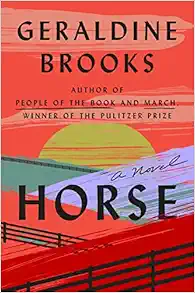
Geraldine Brooks is an author who always draws me into the story, even if I doubt I’m interested in the topic. This historical fiction book includes many fascinating details about horse racing and breeding before, during, and since the American Civil War. There is also a contemporary thread that delves into cleaning carcasses and studying horse skeletons. Characters include present-day scholars who study the anatomy of horses that make them good racehorses and investigate diseases that recent medical improvements have been able to treat. Then there is a whole segment about horse portraiture before and during the Civil War. Since many of the groomers, trainers and other horse caretakers were enslaved and freed during the story’s timeframe, there is a predominant longitudinal theme of race in this well-crafted novel.
Jarret, a fictional Black man whose father had bought his freedom in Kentucky, cares for Lexington, one of the greatest racehorses of all time, throughout the horse’s life. Jarret plans to buy his own freedom, but more importantly, he is dedicated to the stallion he understands better than anyone, including the owners. Each time the horse is sold or sent to another place to train, race, and eventually breed, Jarret manages to accompany him. Jarret seems to empathize with Lexington and sees things from the horse’s point of view. Jarret learns to read and eventually becomes accomplished in the horse business.
Some of the other characters are less developed. Still, the reader gets factual and emotional glimpses of the similarities between the culture of horse owners and enslavers with insights into their tactics and politics. Horses are central to the plot and themes, and the horses are humanized; many people see reflections of themselves and good breeding in their horses. Brooks includes snippets about art collectors in the 1950s and art museums in today’s world. Collectors of horse art and art historians provide worthwhile commentary about the prominent place of horses in American history and interracial relations among the horses’ caretakers. The contemporary messages about social justice could have been more subtle. Yet, I suppose Brooks believes that it was important to be concrete about issues that haven’t been resolved since the Civil War. Of course, since this author is masterful, the various periods and component stories come together beautifully by the end. I highly recommend this book to all readers.


